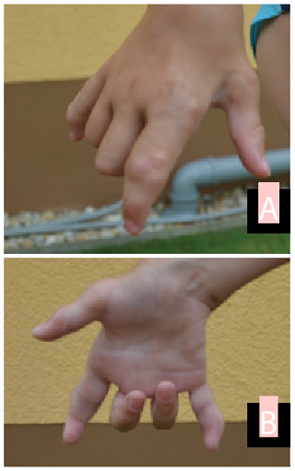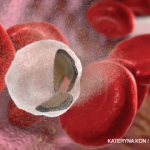After three months, he was also started on etanercept (0.89 mg/kg/week), which led to moderate improvement in pain and general mobility, but not in the range of motion. Starting at age 3 years, he started to develop nodules along the flexor tendons of the hand, as well as the back of the hand and on the dorsal side of the toes.
At that time, the increasing nodules, hoarseness and resistance to antiinflammatory treatment with progressing contractures led to the suspicion of Farber disease. Fibroblast cultures showed highly elevated levels of undegraded ceramide compared with normal controls. A genetic analysis of the ASAH1 gene revealed a homozygous mutation in exon 10 (c.770T>c; p.Leu257Pro). Genetic analysis of the parents confirmed the presence of heterozygous mutations of the same type in both parents.
After the diagnosis was confirmed, treatment with methotrexate and etanercept was discontinued. A course of chloroquine did not lead to significant improvement. Due to worsening joint pains, etanercept was reinstituted at approximately age 5 years, leading to significant improvement in reported pain and mild improvement of arthritis. However, limitations of motion in all large joints, as well as induration and contracture of flexor tendons in the hands progressed despite intensive physiotherapy. A course of injections of dexamethasone in the flexor tendons led to only transient improvement.
Stem cell transplantation was discussed with the parents. However, due to both religious reservations and concerns about the safety of the procedure, no decision was reached. At last follow-up at age 8 years, the patient continues to be mostly pain-free on etanercept (0.84 mg/kg, divided twice weekly), with significant and ongoing limitation of motion, but able to walk and play nonetheless (see Fig. 1 and Fig. 2).

Discussion
Farber disease is an exceptionally rare disease, with 78 patients described worldwide in 2008.1,4 The gene defect was first described in 1972. To date, about 20 mutations in the gene for acid ceramidase (ASAH1) have been described.5 The Leu257Pro mutation found in this patient has not previously been described in children with Farber’s disease. It does not appear to be associated with neurological manifestations, but significant phenotypic variations have been reported for ASAH1 mutations.6

